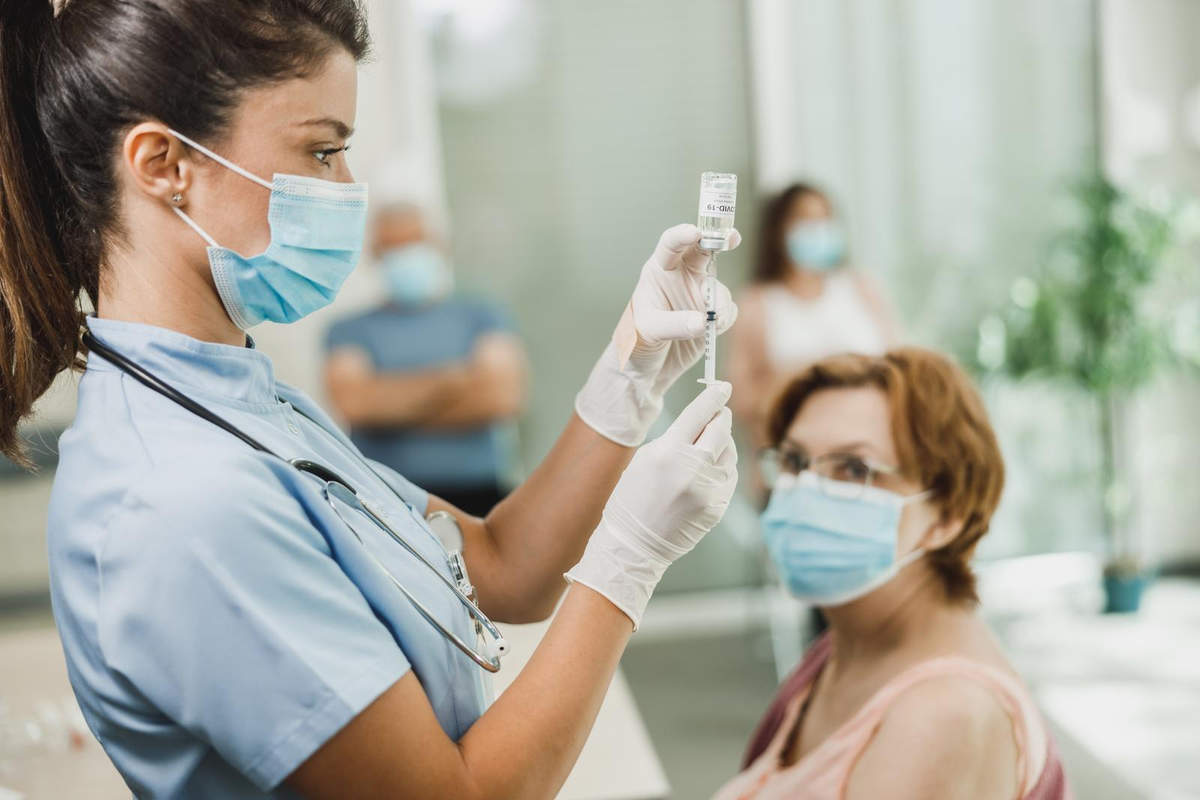Almost three years after the appearance of SARS-CoV-2, it is clear that vaccines have not eradicated the pandemic. On the eve of a new vaccination campaign, let’s take stock with Jean-Marc Sabatier*.
Vaccines against Covid-19 have deleterious effects that sometimes cause vascular accidents, thrombosis and other blood anomalies. How do you explain this?

SARS-CoV-2 infection leads to blood clotting abnormalities in about 15% of infected persons. The same phenomenon is observed in vaccinated persons. About 70-80% of people with severe forms of Covid-19 have coagulation disorders. These abnormalities are due to dysfunction of the host renin-angiotensin system (RAS) induced by the viral Spike protein, and overactivation of its “deleterious” human AT1R receptor. The RAS is a major hormonal and physiological system in our body that controls renal, pulmonary, cardiovascular autonomic functions, as well as innate immunity, and various microbiota (including the gut microbiota). The RAS is ubiquitous and is found in the various organs and tissues of our body.
In short, Covid-19-associated blood clotting abnormalities (resulting from SARS-CoV-2 infection or anti-Covid-19 vaccine injections) are – except in special cases – related to RAS dysfunction (via overactivation of its AT1R receptor induced by the binding of the viral or vaccine Spike protein to the cellular target receptor ECA2).
What role can the SARS-CoV-2 Spike protein play in red blood cells?
Red blood cells (produced in the bone marrow by hematopoietic stem cells) are anucleate cells (in mammals) that are responsible, among other things, for transporting oxygen (oxygen or O2) from the lungs to other tissues and cells in the body. For this vital function, these blood cells contain hemoglobin capable of binding oxygen. It is notable that the role of red blood cells is not limited to oxygen transport: they regulate blood pH, transport immune complexes (thanks to a surface molecule called CD20) and CO2 produced by the cells.
-Aren’t red blood cells the little soldiers in charge of defending us against viruses, bacteria and other pathogenic germs?
Red blood cells are directly involved in our body’s response against microbes. They have a large amount of A-glycophorins on their surface (one million receptors per red blood cell), which serve as a “decoy” for viral proteins (such as the SARS-CoV-2 or vaccine protein Spike). Thus, these blood cells act as “traps” to neutralize circulating pathogens (or to decrease their circulating load), via a direct interaction with their surface proteins. It appears then possible that the Spike protein produced or contained in the anti-Covid-19 vaccines interacts with the red blood cells modifying their properties and behavior.
By what process?
SARS-CoV-2 -via the Spike protein- induces RAS dysfunction via an overactivation of its “deleterious” receptor AT1R. The overactivated AT1R receptor (by the viral or vaccine Spike protein) is pro-hypertensive, pro-inflammatory, pro-oxidant, pro-angiogenic, pro-thrombotic, pro-fibrosing, pro-hypertrophying and causes nitric oxide (NO) to fall. Overactivated AT1R causes hypoxemia (low oxygen levels in the blood) and hypoxia (a state of reduced oxygen availability in the tissues). Recall that overactivation of AT1R (of the RAS) is responsible for macrophage activation syndrome (MAS) and associated hemophagocytosis, which destroys red blood cells and their precursors in the bone marrow. All these data suggest a possible damage to the integrity of red blood cells.
Let’s talk about vaccines. It has been said that they may contain graphene. Your opinion?
Graphene and its derivatives, including graphene oxide, are not described (by manufacturers and WHO) as constituents of vaccines currently used against SARS-CoV-2 and Covid-19. The presence of such nanomaterials is nevertheless mentioned by many authors and experimenters. It would be very serious if the presence of such compounds were real for reasons of health transparency and vaccine safety (although it is not appropriate to talk about vaccine safety in the context of anti-Covid-19 pseudo-vaccines).
Graphene is made of carbon (it is a single layer of carbon atoms organized in honeycombs). With its derivatives, graphene presents exceptional potentialities and physico-chemical properties in terms of lightness, transparency, flexibility, resistance (resistance to breakage 100 times higher than that of steel), stability, electrical conduction, magnetism (only in non-natural conditions), potential source of energy (thanks to vibratory movements), and clean energy storage (graphene battery). The fields of application of these materials are currently expanding as ultra-sensitive sensors/biosensors, biocatalysts, microchips and others, as well as in nanomedicine (mainly as a vector for gene therapy and vaccine platform).
Are these nanoparticles present in vaccines in your opinion?
The major problems posed by the presence of carbonaceous nanomaterials of the graphene or derivative type would potentially be a “deleterious” inflammatory reaction with oxidative stress, cell death (by apoptosis, necrosis and/or autophagic dysfunction) a direct toxicity on organs (in particular the lungs and the brain), a genotoxicity (alteration of the DNA which is a source of cancers and/or deficiencies transmissible to the following generations), as well as the biodegradability (catabolism) and its consequences on the organism. It is noteworthy that to date, undesirable effects of these nanomaterials (e.g. graphene oxide) have already been reported on certain cell types (including nerve and lung epithelial cells), and on living organisms including plants (via carbon nanotube-enriched soil). It appears that the human enzyme myeloperoxidase (MPO) produced by white blood cells (neutrophilic granulocytes belonging to innate immunity) would be able to degrade graphene oxide; these immune cells -in charge of eliminating microbes and foreign bodies in the organism- are strongly represented in the lungs. Finally, graphene nanoparticles (and its derivatives) appear all the more toxic as their size is important. In the case of an effective presence of graphene oxide, or other related compound in mRNA vaccines (which remains to be formally demonstrated to my knowledge), a rapid elimination by a mechanism of phagocytosis of specialized immune cells is probable.
What are the consequences of multiple vaccinations?
The effects of vaccine injections should be more or less “visible” and long-lasting depending on the individual (age, gender, health status, genetic make-up, etc.) and the number of injections received. In my opinion, the real problem linked to the multiple injections of these pseudo-vaccines will be the altered functional potential of the host’s blood. Indeed, these repeated vaccine injections will inevitably lead to a deficiency of the innate immune system (immediate non-specific immunity) and, consequently, to a deficiency of the adaptive/acquired immune system (later immunity of about 4 days and specific to the infectious agent, or other), i.e. to a generalized deficiency of the immune system. Thus, it seems to me urgent and vital to stop these ineffective and deleterious injections, because they will inexorably lead to a major disruption of the immune system in the “vaccinated” persons. The acquired immunodeficiency syndrome (AIDS) could be a lasting modification of immunity in the “vaccinated” host, which could lead to the onset and/or development of various pathologies (cancers, autoimmune diseases, neurodegenerative diseases, etc.).
Do the new bivalent vaccines present the same risks?
The health authorities (European Medicines Agency, and Haute Autorité de Santé) have just approved injections with the new “bivalent” vaccines against Covid-19, as well as their coupling with the flu vaccine. It is noteworthy that these approvals by the authorities are not based -to date- on any clinical trial.
A real vaccine must meet two criteria: efficacy and safety. As far as efficacy is concerned, these new pseudo-vaccines will not be much more effective than their predecessors, even with the addition of one or two messenger RNAs coding for the modified Spike proteins of the Omicron variant (BA.1) and its sublineages BA.4, BA.5. It is clear that the new mRNA vaccines will not prevent either infection or transmission of SARS-CoV-2. These vaccines will not be without side effects because the two or three messenger RNAs, injected simultaneously, are expected to produce Spike proteins that are still potentially capable of binding to the ACE2 receptor of target cells, leading to RAS dysfunction and the potential triggering of Covid-19 diseases. The dangers associated with lipid nanoparticles are still present in these new vaccines. In short, these will provide nothing in terms of protection. These additional vaccine injections will only increase the risk of developing more severe forms of the disease via the ADE and ERD infection facilitation phenomena (in addition to the potential toxicity of lipid nanoparticles present in the vaccines). The benefit-risk balance remains clearly unfavorable with the new vaccines still based on the viral Spike protein. Ideally, from a health point of view, these pseudo-vaccine boosters should be stopped.
*Jean-Marc Sabatier is Director of Research at the CNRS and holds a doctorate in Cell Biology and Microbiology. Editor-in-Chief of the international scientific journals: “Coronaviruses” and “Infectious Disorders – Drug Targets”. He speaks here in his own name.

